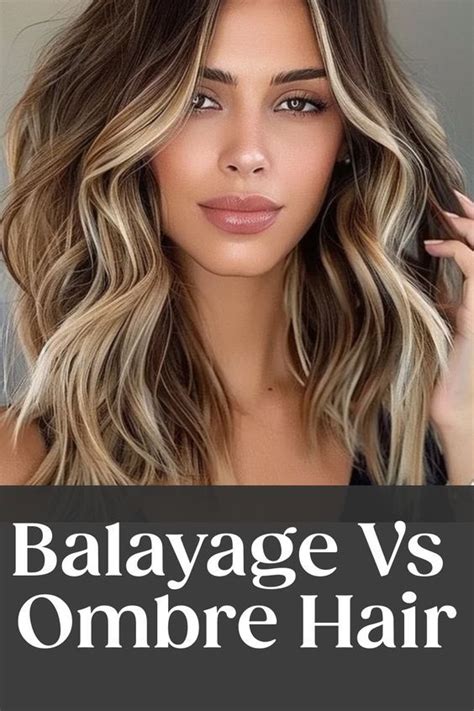Introduction
In the ever-evolving realm of hair artistry, balayage and ombre have emerged as two highly sought-after hair painting techniques. These techniques offer distinct and alluring ways to transform hair, creating captivating shades and dimension. This comprehensive guide delves into the intricacies of balayage and ombre, empowering you to make an informed decision about which technique best suits your hair and style aspirations.

What is Balayage?
Balayage, derived from the French word for “to sweep,” is a freehand hair painting technique that mimics the natural lightening effects of the sun. Color is applied with a brush to specific strands of hair, creating soft, melted transitions from dark to light. The result is a subtle, dimensional look with seamless blending that effortlessly complements your natural hair color.
What is Ombre?
Ombre, meaning “shadow” in French, is a hair painting technique that creates a gradual transition from one color to another. Color is applied from the mid-lengths to the ends of the hair, blending seamlessly from a darker base to a lighter shade. Ombre offers a bolder, more dramatic look that can range from subtle to striking, depending on the color choices and placement.
Key Differences
| Feature | Balayage | Ombre |
|---|---|---|
| Technique | Freehand brush painting | Gradual color transition from mid-lengths to ends |
| Blending | Seamless, melted transitions | Gradual, visible transition |
| Color Placement | Specific strands highlighted | Defined sections of hair colored |
| Effect | Natural, sun-kissed look | Bolder, more dramatic statement |
| Maintenance | Requires less frequent touch-ups | May require more frequent touch-ups, especially at the roots |
Which Technique is Right for You?
The choice between balayage and ombre depends on your desired look and hair type.
- Balayage: Ideal for those seeking a subtle, natural-looking transformation with low maintenance. Well-suited for fine or medium hair textures.
- Ombre: Ideal for those who prefer a bolder, more dramatic look with noticeable color transitions. Suitable for all hair textures, but may require more frequent touch-ups.
Benefits of Balayage
- Natural-looking results: Creates a seamless blend of colors that complements your natural hair tone.
- Low maintenance: Balayage generally requires less frequent touch-ups, as the regrowth is less noticeable.
- Versatile: Can be customized to suit any hair length, texture, or skin tone.
Benefits of Ombre
- Bold, dramatic statement: Creates a striking transition from dark to light, making a statement with your hair.
- Adds depth and dimension: The gradual color transition adds visual interest and volume to the hair.
- Trendy: Ombre remains a popular hair painting technique that offers a fresh and modern look.
Step-by-Step Approach
Balayage
- Section the hair into small sections.
- Apply color to selected strands using a brush, starting from the mid-lengths.
- Blend the color into the natural hair using a tail comb.
- Process the color according to the manufacturer’s instructions.
- Wash and style the hair.
Ombre
- Divide the hair into two sections, horizontal or vertical.
- Apply color to the bottom section, starting from the mid-lengths.
- Blend the color into the natural hair using a brush or comb.
- Process the color according to the manufacturer’s instructions.
- Wash and style the hair.
Tips and Tricks
- Use high-quality products: Invest in a reputable hair color line to ensure optimal results.
- Consult with a professional: Seek guidance from a skilled hair stylist who can assess your hair and recommend the best technique for your needs.
- Start with a subtle change: If you’re unsure about the transformation, opt for a less dramatic color change and gradually increase the intensity as you feel comfortable.
- Maintain your color: Use color-protecting shampoos and conditioners to prolong the vibrancy of your hair color.
- Embrace the trend: Stay up-to-date with the latest hair painting trends to find inspiration for your next color transformation.
Common Mistakes to Avoid
- Overlapping: Avoid applying color to the same strands multiple times, as this can create banding and unevenness.
- Under-processing: Ensure you process the color for the recommended amount of time to achieve the desired results.
- Over-toning: Use toners sparingly to avoid darkening the hair excessively and compromising the natural-looking effect.
- Ignoring root maintenance: Ombre roots can become noticeable over time. Schedule regular touch-ups to maintain the seamless color transition.
- Neglecting hair care: Balayage and ombre techniques can stress the hair. Regularly incorporate nourishing treatments and products into your hair care routine to maintain its health and vibrancy.
Conclusion
Balayage and ombre are transformative hair painting techniques that offer a wide range of color possibilities. By understanding the key differences, you can make an informed decision about which technique is right for you. With careful application and proper maintenance, you can enjoy a beautiful, customized hair color that enhances your natural beauty and reflects your unique style.
